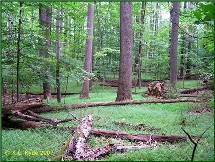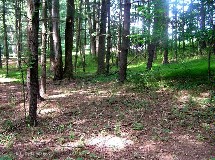The ecosystems in Virginia have evolved over millennia through interactions among organisms. The native plant communities feed and shelter a vast array of insects and other wildlife, which in turn help propagate the plants through pollinating flowers, transporting seeds, and sometimes even altering the habitat to make it easier for plants to grow.
 |
 |
| Many people think the above forest looks lovely and natural. It is not. This wavyleaf basketgrass (Oplismenus hirtellus ssp. undulatifolius) monoculture prevents tree seedlings from germinating and shades out small native plants. (Photo credit: Kerrie Kyde 2007) |
This picture shows the contrast between a healthy forest floor and the astro-turf effect of wavyleaf basketgrass (at left). (Photo credit: Kerrie Kyde 2009) |
Disrupting the Balance by Introducing Exotic Species
Our forests and meadows are communities in which every living thing has a role. Specific insects can eat or pollinate specific plants, nutrients are recycled through the system in a finely balanced way, and different species shelter, feed, or control each other. Each organism, by doing its part, helps create the conditions that the others need to survive.
But because wavyleaf basketgrass did not evolve on this continent, the local insects and other animals either can't or won't eat it. With nothing to slow or stop its growth, it forms a solid carpet on the forest floor, shading out small plants that the animals could eat and leaving no room for seedling trees to sprout. Fewer animals can find food, and with no new trees coming up, the adult trees cannot reproduce.
Luckily, wavyleaf basketgrass is a new invasive and we have a chance to stop it and reverse the damage to our forests and meadows.
Next Section:
Return to a previous section:
Section 1: Where it Grows and What it Looks Like
Section 2: Wavyleaf or an Imposter?
Or learn how to Report A Sighting
